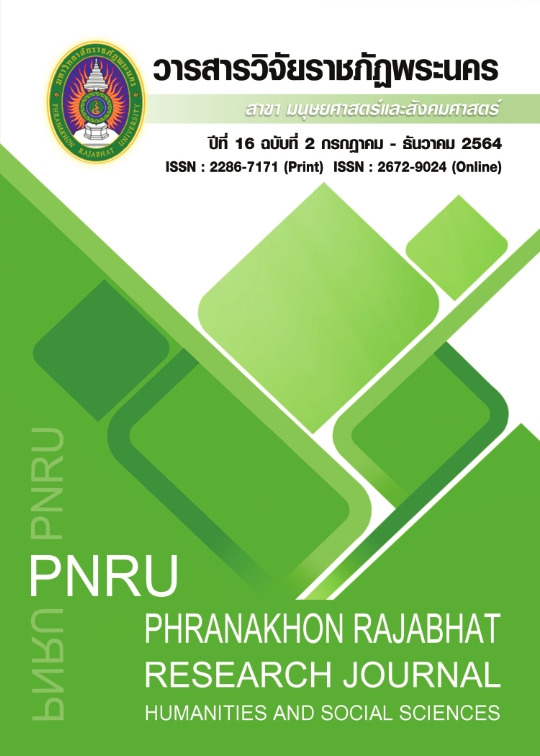ENHANCING ENGLISH GRAMMATICAL COMPETENCE AND WRITTEN PERFORMANCE FOR FIRST YEAR NON-ENGLISH MAJOR UNDERGRADUATES THROUGH A SELF-INSTRUCTIONAL PACKAGE COUPLED WITH PROCESS-BASED WRITING
Main Article Content
Abstract
The objective of the study was to enhance English grammatical competence and written performance for first-year non-English major undergraduate students pursuing their first degree at the Faculty of Humanities and Social Sciences, Phranakhon Rajabhat University through a self-instructional package coupled with process-based writing. Research participants included 30 EFL students from 3 different academic concentrations: business Chinese, community development, and political science. Instruments for data collection comprised a pretest, a posttest, a self-instructional package, and a writing checklist. The self-instructional package included two parts. The first part deal with English grammatical elements needed for writing well-formed sentences. The second part involved an organization of a paragraph and a process of paragraph writing. The findings revealed that after implementing the self-instructional package, research participants were able to write grammatically correct sentences in English. Their posttest scores were higher than the pretest scores at a significance level of .05. The results of the study also showed that participants were able to write basic English texts at a paragraph level.
Article Details
Each publish articles were copyright by Phranakorn Rajabhat University
Any contents which appeared in each articles in the journal were authors personal opinion. It did not relate to Phranakorn Rajabhat University and other instructors in the university. Each authors would take responsibility on their articles. If there are any mistake, the authors will take responsibility themselves
References
Azar, B. (2007). Grammar-based teaching: A practitioner’s perspective. Teaching English as a second or foreign language, 11(2), 1-12.
Burch, J. R. (2007). The impact of scaffolding your children’s acquisition of literacy in primary grades. (Doctoral dissertation). Louisiana College State University. Retrieved from https://digitalcommons.lsu.edu/cgi/viewcontent.cgi?article=2094&context=gradschool_dissertations.
Canale, M., & Swain, M. (1980). Theoretical bases of communicative approaches to second language teaching and testing. Applied Linguistics. 1, 1-47.
Charoento, M. (2018). An analysis of errors committed by Thai EFL non-English major students of the Faculty of Humanities and Social Sciences, Phranakhon Rajabhat University. Phranakhon Rajabhat University.
Culican, S. J., Milburn, S., & Oakley, C. (2006). Scaffolding literacy in the middle years. Department of Education, Science and Training, Australian Government.
Emmons, R. H. (2003). An effective writing formula for unsure writers. Retrieved from http://www.airpower.au.af.mil/airchronicles/aureview/1975/sept.oct/emmons.html.
Ferris, D. R., & Hedgcock, J. S. (2005). Teaching ESL composition: Purpose, process and practice. (2nd Ed.). Mahwah, NJ: Lawrence Erlbaum.
Gunning, T. G. (1998). Assessing and correcting reading and writing difficulties. Boston: Allyn and Bacon.
Huggins, E. & Edwards, R. (2011). Scaffolding to improve reading comprehension and to write a scholarly research paper. International Journal of Humanities and Social Sciences, 1(16), 30-36.
Hyland, K. (2003). Second language writing. New York: Cambridge University Press.
Larsen-Freeman, D. (2014). Teaching grammar. In M. Celce-Murcia, D. M. Brinton, & M. A. Snow, Teaching English as a second or foreign language (4th Ed.). Boston, MA: National Geographic Learning.
Liang, J. (2007). Language scaffolding in second language writing. The CATESOL Journal, 19(1), 71-86.
Mala, D. (2019, April 4). Obec brands O-Net fails a success. Retrieved from https://www.bangkokpost.com/thailand/general/1656204/obec-brands-o-net-fails-a-success.
Nunan, D. (1991). Language Teaching Methodology. Hertfordshire: Prentice Hall International.
Olson, C. B., & Land, R. (2007). A cognitive strategies approach to reading and writing instruction for English language learners in secondary school. Research in the Teaching of English, 41(3), 269-303.
Palmer, B. C., Hafiner, M. L., & Sharp, M. F. (1994). Developing cultural literacy through the writing process: Empowering all learners. MA: Allyn and Bacon.
Parker, S. (1993). The craft of writing. London: Paul Chapman Publishing.
Riazi, M., & Rezaii, M. (2011). Teacher- and peer-scaffolding behaviors: Effects on EFL students’ writing improvement. In A. Feryok (Ed.), CLESOL 2010: Proceedings of the 12th National Conference for Community Languages and ESOL, 55-63.
Safadi, E., & Rababah, G. (2012). The effect of scaffolding instruction on reading comprehension skills. Journal of Language Studies, 6(2), 1-38.
Sharma, H. L. (2000). Development of self-instructional materials in educational statistics for M. Ed. Programme through distance mode. Journal of Distance Education, 69-76.
Stanley, G. (1993). Process writing. Barcelona: British Council.
Steele, V. (1992). Product and process writing: a comparison. Rowley: Newbury House.
Tribble, C. (1996). Writing. Oxford: Oxford University Press.
Zamel, V. (1983). The composing processes of advanced ESL students: six case studies. In K. Hyland (ed.), Second language writing. New York: Cambridge University Press.


